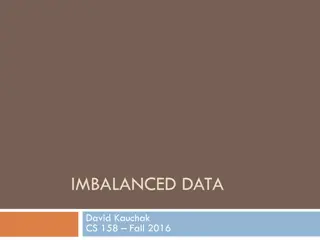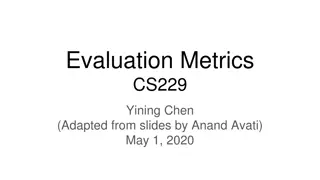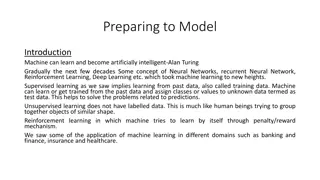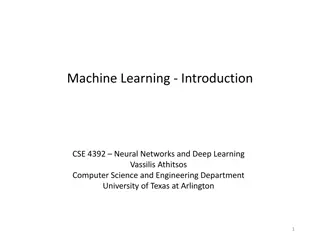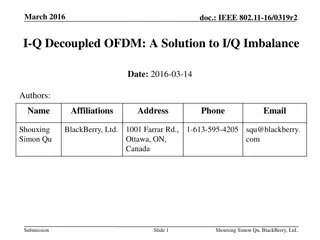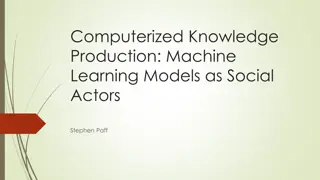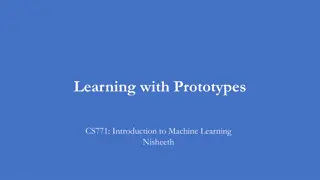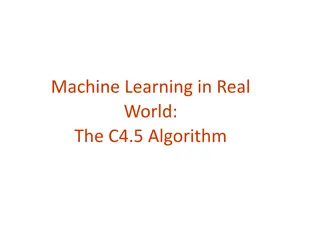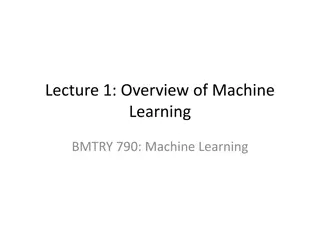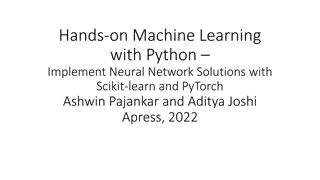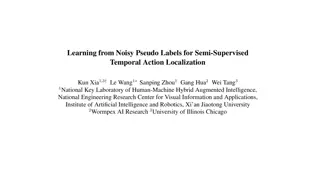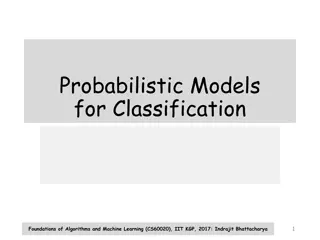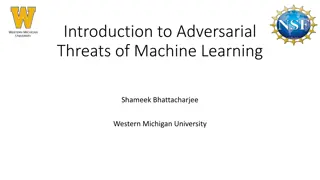Dealing with Class Imbalance in Machine Learning: Strategies and Solutions
Addressing the challenge of imbalanced datasets in machine learning is crucial, as standard classifiers tend to favor majority classes, leading to poor performance on minority classes. This imbalance can impact various domains, such as fraud detection and cancer diagnosis. Strategies like data balancing and model evaluation are essential for improving overall performance.
Download Presentation

Please find below an Image/Link to download the presentation.
The content on the website is provided AS IS for your information and personal use only. It may not be sold, licensed, or shared on other websites without obtaining consent from the author. Download presentation by click this link. If you encounter any issues during the download, it is possible that the publisher has removed the file from their server.
E N D
Presentation Transcript
ENG6600: Advanced Machine Learning ENG6600: Advanced Machine Learning Data Preparation Data Balancing (Part 4) S. Areibi S. Areibi School of Engineering School of Engineering University of Guelph University of Guelph
You trained a model to predict cancer from image data using a state of the art Hierarchical siamese CNN with dynamic kernel activations Your model has an accuracy of 99.9% An imbalanced classification problem is an example of a classification problem where the distribution of examples across the known classes is biased or skewed. 3
Something is Wrong!! By looking at the confusion matrix you realize that the model does not detect any of the positive examples. 4
After plotting your class distribution you see that you have thousands of negative examples but just a couple of positives. negatives positives 5
Classifiers try to reduce the overall error so they can be biased towards the majority class. # Negatives = 998 # Positives = 2 By always predicting a negative class the accuracy will be 99.8% Your dataset is imbalanced!!! Now What??? 6
The Class Imbalance Problem Data sets are said to be balanced if there are, approximately, as many positive examples of the concept as there are negative ones. There exist many domains that have unbalanced data sets. Examples: a) Helicopter Gearbox Fault Monitoring b) Discrimination between Earthquakes and Nuclear Explosions c) Document Filtering d) Detection of Oil Spills e) Detection of cancerous cells f) Detection of Fraudulent Telephone Calls g) Detection of hotspots in ASIC/FPGA Placements h) Detection of unrouteable designs in VLSI i) Fraud and default prediction j) Mail Spam Detection 7
The Class Imbalance Problem The problem with class imbalances is that standard learners are often biased towards the majority class. That is because these classifiers attempt to reduce global quantities such as the error rate, not taking the data distribution into consideration. As a result, examples from the overwhelming class are well-classified whereas examples from the minority class tend to be misclassified. 8
The Class Imbalance Problem For classification problems, we often use accuracy as the evaluation metric. It is easy to calculate and intuitive: Accuracy = # of correct predictions / # of total predictions But, it is misleading for highly imbalanced datasets!!. For example, in credit card fraud detection, we can set a model to always classify new transactions as legit. The accuracy could be high at 99.0% if 99.0% in the dataset is all legit. But, don t forget that our goal is to detect fraud, so such a model is useless. 9
Solutions to Imbalanced Learning Data Level Sampling methods Algorithmic Level Cost-sensitive methods Kernel and Active Learning methods 11
Several Common Approaches At the data Level: Re-Sampling Oversampling (Random or Directed) o Add more examples to minority class Undersampling (Random or Directed) o Remove samples from majority class At the Algorithmic Level: Adjusting the Costs or weights of classes Adjusting the decision threshold / probabilistic estimate at the tree leaf Most of the machine learning models provide a parameter called class weights 12
Sampling Methods Create balance through sampling Create balanced dataset If data is Modify data distribution Imbalanced A widely adopted technique for dealing with highly unbalanced datasets is called resampling. 1. Removing samples from the majority class (under-sampling). 2. Adding more examples to the minority class (over-sampling). 3. Or perform both simultaneously: Under-Sample the majority & Over-Sample the minority 13
Sampling Methods Create balance though sampling Oversampling may just randomly replicate records within the dataset!! Can cause overfitting! Can cause loss of information. Advantages and disadvantages of Under-sampling and Oversampling? 14
SMOTE: Resampling Approach SMOTE stands for: Synthetic Minority Oversampling Technique It is a technique designed by Hall et. al in 2002. SMOTE is an oversampling method that synthesizes new plausible examples in the minority class. SMOTE not only increases the size of the training set, it also increases the variety!! SMOTE currently yields the best results as far as re- sampling and modifying the probabilistic estimate techniques go (Chawla, 2003). 17
SMOTEs Informed Oversampling Procedure For each Minority Sample I. Find its k-nearest minority neighbors II. Randomly selectj of these neighbors III.Randomlygenerate synthetic samples along the lines joining the minority sample and its j selected neighbors (j depends on the amount of oversampling desired) For instance, if it sees two examples (of the same class) near each other, it creates a third artificial one, in the middle of the original two. 18
SMOTE Synthetic Minority Oversampling Technique (SMOTE) along the lines joining the minority sample and its j selected neighbors Find its k-nearest minority neighbors Randomly select j of these neighbors Randomly generate synthetic samples 19
SMOTEs Shortcomings Overgeneralization a) SMOTE s procedure may blindly generalizes the minority area without regard to the majority class. b) It may oversample noisy samples c) It may oversample uninformative samples Lack of Flexibility a) The number of synthetic samples generated by SMOTE is fixed in advance, thus not allowing for any flexibility in the re-balancing rate. b) It would be nice to increase the minority class just to the right value (i.e., not excessive) to avoid the side affects of unbalanced datasets 21
Cost-Sensitive Approach Cost-sensitive learning is a subfield of machine learning that takes the costs of prediction errors (and potentially other costs) into account when training a machine learning model. Log. regression doesn t support imbalanced classification directly. Instead, the training algorithm used to fit the log. regression model must be modified to take the skewed distribution into account. This can be achieved by specifying a class weighting configuration that is used to influence the amount that logistic regression coefficients are updated during training. The weighting can penalize the model less for errors made on examples from the majority class and penalize the model more for errors made on examples from the minority class. The result is a version of logistic regression that performs better on imbalanced classification tasks, generally referred to as cost- sensitive or weighted logistic regression. https://machinelearningmastery.com/cost-sensitive-logistic-regression/ 23
Cost-Sensitive Approach In Logistic regression, we calculate loss per example using binary cross-entropy: o Loss = y log(p(y)) (1 y) log(1 p(y)) o where y is the label (1 for class A and 0 for class B) o and p(y) is the predicted probability of the point being class A. In this particular form, we give equal weight to both the positive and the negative classes. However, if we set class_weight as class_weight = {0:1,1:20}, the classifier in the background tries to minimize: NewLoss = 20*y log (p(y)) 1*(1 y) log (1 p(y)) That means we penalize our model around 20 times more when it misclassifies a positive minority example in this case. 24
Assessment Metrics How to evaluate the performance of imbalanced learning algorithms ? 1. Singular assessment metrics 2. Receiver operating characteristics (ROC) curves 3. Precision-Recall (PR) Curves 4. Cost Curves 5. Assessment Metrics for Multiclass Imbalanced Learning 25
Assessment Metrics Singular Assessment Metrics Limitations of accuracy sensitivity to data distributions Misleading Accuracy 26
Assessment Metrics Singular Assessment Metrics Precision: It tells us how correct (precise) our model s positive predictions. Recall (Sensitivity): is the ratio of correctly predicted positive classes to all items that are actually positive Insensitive to data distributions 27
TPR and TNR Predicted T Predicted F Actually FN TP T Actually F FP TN True Positive Rate (TPR) is the probability that an actual positive will test positive (Sensitivity/Recall). True Negative Rate (TNR) is the probability that an actual negative will test negative (called Specificity). 28
SKLearn Code The dataset is about Abalone. Abalone, is a species of marine snails. There are 4174 instances with 8 features for each record % of Negative instances: 99.23% % of Positive instances: 0.77% Our goal is to identify whether an abalone belongs to a specific class. (Positives 19), (Negative all remaining). So, this is a binary classification problem of either positive (class 19) or negative. You can download the data from the following link https://github.com/liannewriting/YouTube-videos-public/tree/main/imbalanced-data-machine-learning-abalone19 https://www.youtube.com/watch?v=xFErz6I-FyE&list=PL2L4c5jChmctqiXvOaJA91o0OJhYq1rR9&index=1 30
SKLearn Code # How to handle Imbalanced Data in machine learning classification # The slides presented are based on the following Tutorial # https://www.justintodata.com/imbalanced-data-machine-learning-classification/ # This tutorial will focus on imbalanced data in machine learning for binary classes, # but you could extend the concept to multi-class. import pandas as pd from imblearn.over_sampling import RandomOverSampler from imblearn.under_sampling import RandomUnderSampler from imblearn.over_sampling import SMOTE from imblearn.under_sampling import ClusterCentroids from imblearn.combine import SMOTETomek from imblearn.under_sampling import TomekLinks from sklearn.linear_model import LogisticRegression from sklearn.metrics import roc_auc_score from sklearn.model_selection import train_test_split from sklearn.utils import compute_class_weight 31
SKLearn Code # Read the dataset df = pd.read_csv('abalone19.dat') df.head() Sex Length Diameter Height W_weight S_weight V_weight Shell_weight 0.455 0.365 0.095 0.5140 0.2245 0.1010 0.150 0.350 0.265 0.090 0.2255 0.0995 0.0485 0.070 0.530 0.420 0.135 0.6770 0.2565 0.1415 0.210 0.440 0.365 0.125 0.5160 0.2155 0.1140 0.155 0.330 0.255 0.080 0.2050 0.0895 0.0395 0.055 Class negative negative negative negative negative 0 M 1 M 2 F 3 M 4 I 32
SKLearn Code # Find out more about the dataset df.info() <class 'pandas.core.frame.DataFrame'> RangeIndex: 4174 entries, 0 to 4173 Data columns (total 9 columns): # Column Non-Null Count Dtype --- --------- ------------------ -------- 0 Sex 4174 non-null object 1 Length 4174 non-null float64 2 Diameter 4174 non-null float64 3 Height 4174 non-null float64 4 Whole_weight 4174 non-null float64 5 Shucked_weight 4174 non-null float64 6 Viscera_weight 4174 non-null float64 7 Shell_weight 4174 non-null float64 8 Class 4174 non-null object dtypes: float64(7), object(2) memory usage: 293.6+ KB 33
SKLearn Code # Produce some stats on the dataset df.describe() Length Diameter 4174.0 4174.0 0.5240 0.4079 0.1200 0.0991 Height 4174.0 0.139524 0.041818 0.000000 0.115000 0.140000 0.165000 1.130000 Whole_weight 4174.0 0.828771 0.490065 0.002000 0.442125 0.799750 1.153000 2.825500 Shucked_weight 4174.0 0.359361 0.221771 0.001000 0.186500 0.336000 0.501875 1.488000 Viscera_weight 4174.0 0.180607 0.109574 0.000500 0.093500 0.171000 0.252875 0.760000 Shell_weight 4174.0 0.238853 0.139143 0.001500 0.130000 0.234000 0.328875 1.005000 Class 4174.000000 0.007667 0.087233 0.000000 0.000000 0.000000 0.000000 1.000000 Sex_I Sex_M 4174.0 4174.0 0.321275 0.365597 0.467022 0.481655 0.000000 0.000000 0.000000 0.000000 0.000000 0.000000 1.000000 1.000000 1.000000 1.000000 Count Mean Std Min 0.0750 0.0550 25% 0.4500 0.3500 50% 0.5450 0.4250 75% 0.6150 0.4800 Max 0.8150 0.6500 34
SKLearn Code # We ll use the most basic machine learning classification algorithm: logistic regression. # It is better to convert all the categorical columns for logistic regression to dummy variables. # we ll convert the categorical columns (Sex and Class) within the dataset before modeling. # Lets look at the category of Sex # Three Classes: Male, Infant and Female df['Sex'].value_counts() M 1526 I 1341 F 1307 Name: Sex, dtype: int64 # Lets look at the category of Class # Two Classes: Negative and Positive df['Class'].value_counts() 35
SKLearn Code # Let us convert the Class label into 0 and 1 df['Class'] = df['Class'].map(lambda x: 0 if x == 'negative' else 1) df Sex Length 0.455 0.350 0.530 0.440 0.330 ... 0.560 0.565 0.590 0.600 0.625 Diameter 0.365 0.265 0.420 0.365 0.255 ... 0.430 0.450 0.440 0.475 0.485 Height Whole_weight 0.095 0.5140 0.090 0.2255 0.135 0.6770 0.125 0.5160 0.080 0.2050 ... ... 0.155 0.8675 0.165 0.8870 0.135 0.9660 0.205 1.1760 0.150 1.0945 Shucked_weight Viscera_weight Shell_weight Class 0.2245 0.1010 0.0995 0.0485 0.2565 0.1415 0.2155 0.1140 0.0895 0.0395 ... ... 0.4000 0.1720 0.3700 0.2390 0.4390 0.2145 0.5255 0.2875 0.5310 0.2610 0 M 1 M 2 F 3 M 4 I ... ... 4169 M 4170 F 4171 M 4172 M 4173 F 0.1500 0 0.0700 0 0.2100 0 0.1550 0 0.0550 0 ... 0.2290 0 0.2490 0 0.2605 0 0.3080 0 0.2960 0 ... 4174 rows 9 columns 36
SKLearn Code # Let us convert the Sex feature into two dummy variables df = pd.get_dummies(df, columns=['Sex'], drop_first=True) df Length Diameter 0 0.455 1 0.350 Height Whole_weight Shucked_weight Viscera_weight Shell_weight Class Sex_I Sex_M 0.095 0.5140 0.2245 0.1010 0.1500 0 0 1 0.090 0.2255 0.0995 0.0485 0.0700 0 0 1 0.365 0.265 4174 rows 10 columns 37
SKLearn Code df['Class'].value_counts(normalize=True) 0 0.992333 1 0.007667 Name: Class, dtype: float64 df['Class'].value_counts().plot(kind='bar') 38
SKLearn Code # Splitting Training and Testing sets # Let s split the dataset into training (80%) and test sets (20%). # Use the train_test_split function with stratify argument based on Class categories. # So that both the training and test datasets will have similar portions of classes as # the complete dataset. # This is important for imbalanced data. df_train, df_test = train_test_split(df, test_size=0.2, stratify=df['Class'], random_state=888) features = df_train.drop(columns=['Class']).columns 39
SKLearn Code # Two sets: df_train and df_test. # We ll use df_train for modeling, and df_test for evaluation. # Print the different classes (0 and 1) that are present in the Training Set df_train['Class'].value_counts() Training Data 0 3313 1 26 Name: Class, dtype: int64 # Print the different classes (0 and 1) that are present in the Testing Set df_test['Class'].value_counts() Testing Data 0 829 1 6 Name: Class, dtype: int64 40
SKLearn Code # Let us train a Logistic Regression with the unbalanced Data and check the auc clf = LogisticRegression(random_state=888) features = df_train.drop(columns=['Class']).columns clf.fit(df_train[features], df_train['Class']) y_pred = clf.predict_proba(df_test[features])[:, 1] print("The AUC score for this model using the original unbalanced data ...") roc_auc_score(df_test['Class'], y_pred) The AUC score for this model using the original unbalanced data ... 0.683956574185766 TPR FPR 41
SKLearn Code # we could use the library imbalanced-learn to random oversample. from imblearn.over_sampling import RandomOverSampler from imblearn.under_sampling import RandomUnderSampler from imblearn.over_sampling import SMOTE ros = RandomOverSampler(random_state=888) X_resampled, y_resampled = ros.fit_resample(df_train[features], df_train['Class']) y_resampled.value_counts() 0 3313 1 3313 Name: Class, dtype: int64 42
SKLearn Code # We can then apply Logistic Regression and calculate the AUC metric. clf = LogisticRegression(random_state=888) clf.fit(X_resampled, y_resampled) y_pred = clf.predict_proba(df_test[features])[:, 1] print("The AUC score for this model after Random Over Sampling ...") roc_auc_score(df_test['Class'], y_pred) The AUC score for this model after Random Over Sampling ... 0.838962605548854 43
SKLearn Code # Random sampling is easy, but the new samples don t add more information. # SMOTE improves on that. # SMOTE oversamples the minority class by creating synthetic examples. # It involves some methods (nearest neighbors), to generate plausible examples. print("Oversampling using SMOTE ...") from imblearn.over_sampling import SMOTE smote = SMOTE(random_state=888) X_resampled, y_resampled = smote.fit_resample(df_train[features], df_train['Class']) y_resampled.value_counts() Oversampling using SMOTE ... 0 3313 1 3313 Name: Class, dtype: int64 44
SKLearn Code # We ll apply logistic regression on the balanced dataset and calculate its AUC. clf = LogisticRegression(random_state=888) clf.fit(X_resampled, y_resampled) y_pred = clf.predict_proba(df_test[features])[:, 1] print("The AUC score for this model after SMOTE ...") roc_auc_score(df_test['Class'], y_pred) The AUC score for this model after SMOTE ... 0.7913148371531966 45
SKLearn Code # Now we will use Undersampling # Undersampling, we will downsize majority class to balance with the minority class. # Simple random undersampling # We ll begin with simple random undersampling. rus = RandomUnderSampler(random_state=888) X_resampled, y_resampled = rus.fit_resample(df_train[features], df_train['Class']) y_resampled.value_counts() 0 26 1 26 Name: Class, dtype: int64 46
SKLearn Code # And this produces the same AUC as pandas undersampling, since we use the same clf = LogisticRegression(random_state=888) clf.fit(X_resampled, y_resampled) y_pred = clf.predict_proba(df_test[features])[:, 1] print("The AUC score for this model after Under Sampling ...") roc_auc_score(df_test['Class'], y_pred) The AUC score for this model after Under Sampling ... 0.6465621230398071 47
SKLearn Code # Weighing classes differently # We can also balance the classes by weighing the data differently # We usually consider each observation equally, with a weight value of 1 # But for imbalanced datasets, we can balance the classes by putting more weight # on the minority classes. # The below code estimates weights for our imbalanced training dataset. weights = compute_class_weight('balanced', classes=df_train['Class'].unique(), y=df_train['Class']) print("If we want the dataset to be balanced, we need the following weights for Majority vs Minority ..") weights If we want the dataset to be balanced, we need the following weights for Majority vs Minority .. array([ 0.50392394, 64.21153846]) 50
SKLearn Code # Let s verify that these weights can indeed balance the dataset. # Multiply the counts of each class by their respective weights. print("Performing the following re-wieghting of classes we get ..") print((df_train['Class'] == 0).sum()*weights[0]) print((df_train['Class'] == 1).sum()*weights[1]) Performing the following re-wieghting of classes we get .. 1669.5 1669.5000000000002 51
SKLearn Code # All right! So now you ve got the idea of how to weigh classes differently. # What does this mean for a machine learning algorithm like logistic regression? # Different weights make it cost more to misclassify a minority than majority class # We can use code below to apply LR to the differently weighted datasets, # with the extra argument class_weight='balanced . clf_weighted = LogisticRegression(class_weight='balanced', random_state=888) clf_weighted.fit(df_train[features], df_train['Class']) y_pred = clf_weighted.predict_proba(df_test[features])[:, 1] print("The AUC score after using Weighted Logistic Regression (balanced) ...") roc_auc_score(df_test['Class'], y_pred) The AUC score for this model after using Weighted Logistic Regression (balanced) ... 0.8275030156815439 52
Summary o Imbalanced data occurs when the classes of the dataset are distributed unequally. It is common for machine learning classification prediction problems. o The challenge of working with imbalanced datasets is that most machine learning techniques will ignore, and in turn have poor performance on, the minority class, although typically it is performance on the minority class that is most important. o One approach to addressing imbalanced datasets is to oversample the minority class. The simplest approach involves duplicating examples in the minority class (Random Oversampling), although these examples don t add any new information to the model. o Instead, new examples can be synthesized from the existing examples. This is a type of data augmentation for the minority class and is referred to as the Synthetic Minority Oversampling Technique, or SMOTE for short. 55





